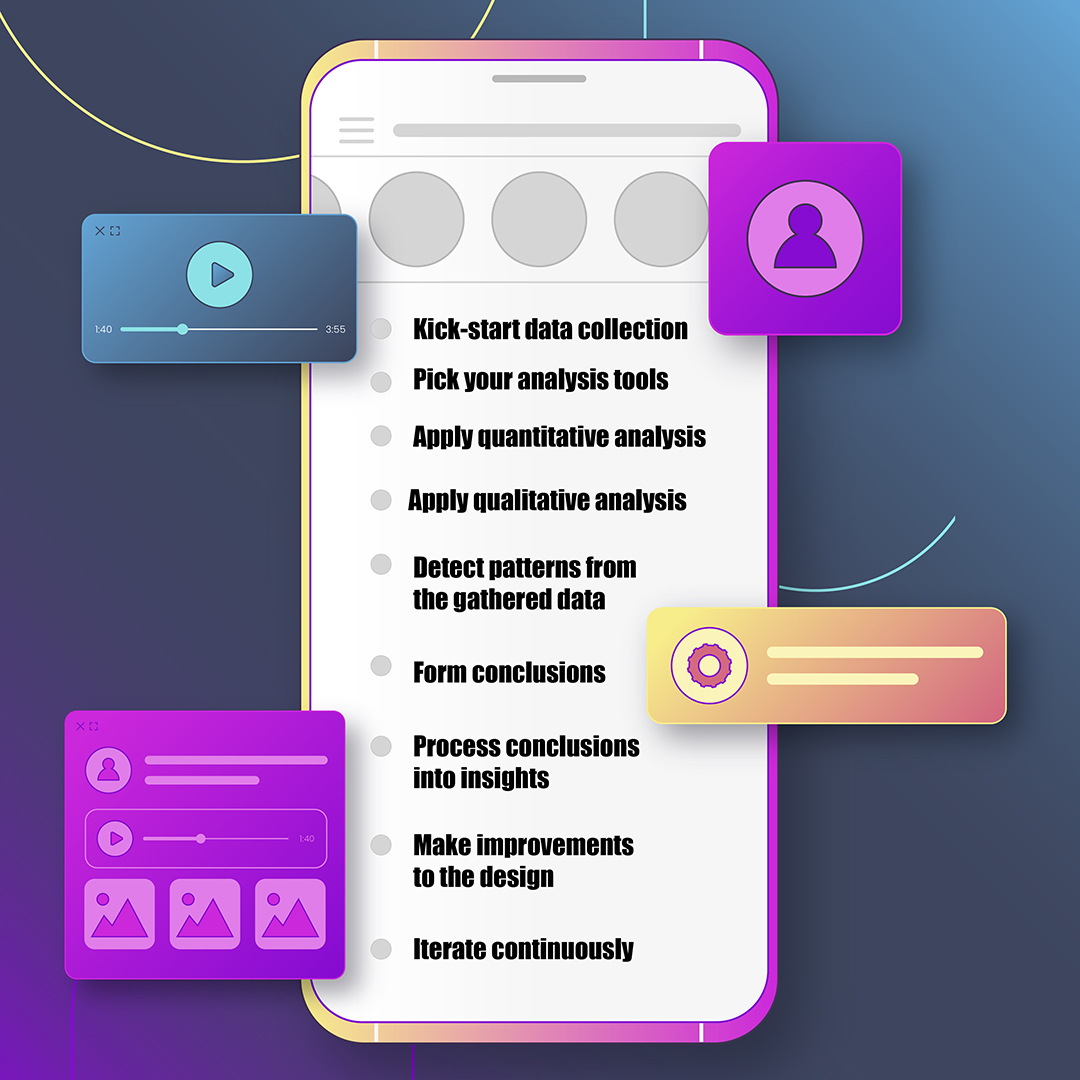The Key to User Insights: A Comprehensive Guide to UX Research Methods
Assume your concept is only a speck and UX research is what converts it into an exceptional one. It has to be treated with the same care and focus you showed when you originally considered it. That's the key to bringing your concept to life with user experience research and UX design research.
It is important to understand how others will tap into and appreciate what you've created with UX methodologies implemented by a seasoned UX research agency. Whether you're asking them questions, seeing how they engage with it, or testing new things, you should ensure that it receives every bit of commitment from your end with the help of UX services.
Making your concept into a wonderful experience requires more than simply having a solid idea. It is about making an effort to ensure that it develops and flourishes just as you envisioned. For that, you need user experience methodologies. They are the hands-on attention that guarantees your concept transforms into an excellent experience for those who use it.
Need help with the difference between UI and UX? Here’s a great blog to read.
Now let's explore everything you need to know about UX research.
What Is Meant by UX Research?
UX research is the process of analyzing user behaviors, needs, and motivations using a series of approaches. It is about digging into the user's reality to improve the entire design process with the help of an expert UX service provider. User experience methodologies include quantitative approaches like surveys and analytics, as well as qualitative ones such as interviews and usability testing. This diversity in UX design research promotes a comprehensive knowledge to go all out on the goal of understanding users.
The Potential Benefits Of UX Research
1. Making Well-Informed Decisions
Partnering with an established UX research agency enables designers and stakeholders to make meaningful decisions based on actual user feedback.
2. Enhanced User Satisfaction
UX methodologies can match design with user preferences thereby enhancing user satisfaction levels, leading to increased user engagement.
3. Cost-Efficiency
Investing in user experience research early in the design process can help save expenses by avoiding costly redesigns later.
User experience research statistics show that focusing on the practical aspect of user experience methodologies ensures a better return on investment (ROI). You may demonstrate concrete gains through user research, such as greater performance, credibility, exposure, and revenue growth. UX design research is more than simply making things seem beautiful; it is also about helping them operate better, saving resources, and increasing efficiency.
Core Methods of User Experience Research
Qualitative Methods
Qualitative UX research is analogous to journeying into unknown territory. Its primary function is to go deep and discover why people do what they do and what they truly want (say, in a mobile app development project). UX services allow you to dive deeper into user thoughts to comprehend their motives and requirements.
User experience research helps you mold your thoughts and develop hypotheses as well. These concepts may then be evaluated using quantitative procedures, which are similar to the tools used to accurately make and measure things.

Qualitative UX methodologies or approaches are neither rigorous nor stringent, yet they might be subjective because they are based on people's ideas. They are gentler on science, focusing more on ideas and hypotheses.
Typically, qualitative user experience methodologies include smaller groups of individuals and require someone to manage idea sharing. It is hands-on and direct, collecting data directly from people about their habits and beliefs.
User Interviews
UX design research involves casual conversations with users and can truly help you know them (especially in website development projects). You can learn about their experiences, likes, and dislikes in depth. Generally speaking, interviews for UX research come into two categories:
- Structured interviews entail the interviewer asking structured questions and comparing the interviewee's replies to those of other interviewers.
- Semi-structured interviews are ones in which the interviewer adopts a more relaxed, discussion-based approach, enabling the interview to flow more naturally.
Usability Testing
Consider seeing people utilize your design similar to different forms of observations on other works. Designers in an accomplished UX research agency may identify problems and improve the design by seeing consumers in action.
Card Sorting
By doing UX design research, you can consider arranging information in the same way you would sort a deck of cards. Users contribute to the sorting of information, making it simpler for them to find what they're looking for.
Tree Testing
This type of UX research is like a treasure quest for knowledge. Users observe the structure of a website to determine how easily they can discover what they are looking for. This enables UX service experts or designers to develop a navigation system that functions similarly to a clear roadmap.
Ethnographic Research
This user experience research approach will help you enter the user's world as an explorer. Immersing oneself in their environment provides a hawk-eyed perspective of their actions. It is about knowing their lifestyle, not simply how they use your products.
In a word, qualitative UX design research is the first step toward knowing your consumers. It is a little like talking with them to figure out what makes them tick before you dig into more systematic and detailed techniques for analyzing their preferences.
Quantitative Methods
Quantitative UX research helps you measure your ideas and understand if they work. Its primary function is to test your assumptions and ensure that your ideas are on the proper route. This type of user experience research allows you to fine-tune your ideas after you've created theories using other approaches, such as qualitative research.
Quantitative approaches from a UX research agency are more like following a well-defined strategy. They are systematic and objective, emphasizing concrete, quantifiable data. It is the more exact aspect of science, concerned with testing hypotheses to determine if they hold up.
Quantitative UX research methodologies, as opposed to qualitative research, involve bigger groups of individuals. The good thing is that you can run it in a more hands-off manner, so you don't have to be personally active. You obtain knowledge indirectly, such as by watching from a distance.
Surveys
Consider giving out digital surveys to a large number of individuals. This user experience research methodology is similar to asking consumers to vote on things they like or detest. Focusing on individual data allows you to discover exactly what makes people happy.
A/B Testing
This form of UX research helps you understand what design variation people prefer. A/B testing compares several versions to see which works better. It is similar to a design competition, with the winner being the one that consumers like the most.
Analytics
UX services leverage tools to monitor how people engage with digital platforms. It is like observing everything in the background to see what users are doing. These insights are invaluable, allowing designers to make informed decisions based on actual user behavior.
Finally, quantitative user experience research helps you gather a large amount of data. It allows you to view the broad picture and guarantees that your ideas are not only sound in principle but also work when tested on a larger scale.
These key UX design research approaches allow designers to perceive the user experience from numerous perspectives. Whether it is collecting poll data through surveys or exploring the user's environment through ethnographic research, each technique contributes a unique piece to the jigsaw of developing designs that users will like.
Methods for Doing Advanced UX Design Research
Eye Tracking
This is one of the UX methodologies that plots a digital map of user eye movements on a screen. It enables designers to improve areas that draw attention.
Biometric Research
Another one of the user experience methodologies that functions similarly to a mood tracker. Designers may learn about their users' emotions by monitoring their heart rate and skin responses. It is about understanding what consumers see and how it affects them emotionally.
Diary Studies
A UX research agency can discreetly monitor users' interactions and thoughts over time. By observing their activities, they can learn about their changing interactions. You take notes and reflect afterward.
Guerrilla Usability Testing
It is a short and causal research approach in user experience methodologies. It is similar to a positive conversation with consumers. This is quicker for gaining instant feedback on how people engage with a design in their daily lives.
How to Apply Your UX Research Findings?
Data Analysis and Interpretation
This is a cyclical process when it comes to UX research. You arrive at where you started and begin the process again in a repeated manner. The below image will help you understand better.

Read about data-driven UX strategy here.
Persona Creation
This UX research approach helps you create characters for a narrative based on what you've learned from consumers. Personas help designers understand and humanize their target audience. It is like putting together a cast of actual users with real needs.
Reporting and Sharing Findings
Communicating results clearly to stakeholders is critical for building teamwork and allowing informed decision-making through UX services. It is like transforming research data into a narrative that directs the design process.
Finally, any study is only valuable if carefully analyzed. Conducting user experience research without competent analysis makes little sense. When we apply different UX research methodologies, it is critical to seek relationships and patterns in the results. The purpose is to see if different user experience research methodologies result in the same findings. This procedure, known as triangulation, combines many study points from diverse methods to increase our confidence in the findings and assumptions. The more data points we analyze, the more certain we may be of our findings.
The more data points we gather through UX research, we can be more certain about our assumptions. We can increase the accuracy of our findings by identifying places of overlap between our various user research approaches.
Conclusion
UX research is a revolutionary approach that enables designers and organizations to build user-centered products and experiences. It can help you understand user needs, habits, and motivations to build solutions that resonate and provide value.
So, make user experience research a core component of your design process. Learn from your achievements and mistakes, follow industry best practices, and let data inform your design decisions. Also, make sure you partner with an expert UX research agency to bring your research efforts closer to your consumers, improve your products, and have a lasting impact.


